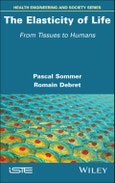The protection and maintenance of this capital is one of life’s priorities since this declination begins at the age of twenty and accelerates in times of crises and pandemics. However, there are no therapies yet designed to remedy it.
The first part of the book explains the consequences surrounding a lack of elasticity in the skin, the most visible decline, and then other defects in elasticity throughout our bodies, exploring places rarely mentioned. The second part describes the research fighting against elasticity anomalies and examines useful behaviors to protect our elastic capital (e.g. our diets and physical and cognitive activities). This last point is at the heart of current social debates on nutritional, behavioral, environmental and even ethical levels.
Table of Contents
Foreword ix
Yves RÉMOND
Preface xiii
Acknowledgments xv
Introduction xix
Part 1 Fantastic Elastic Capital 1
Chapter 1 Strengths and Weaknesses of the Elastic Human 3
1.1 Introduction 3
1.2 Longevity and elasticity 4
1.3 Disasters 4
1.3.1 Fibrosis of infectious origin 5
1.3.2 The great pandemics 6
1.4 Cutaneous elastic capital 8
1.4.1 Introduction 9
1.4.2 Wrinkles and scars 9
1.4.3 Beautiful skin 11
1.4.4 The elastic network of the dermis 13
1.5 Loose skin and cutis laxa 15
1.6 What is missing and malfunctioning in these fiber diseases? 19
1.7 What structures and strengthens the elastic system 20
1.7.1 The mechanical actors 21
1.7.2 Cross-links 23
1.7.3 Calcification 25
Chapter 2 Elastic Capital, Air, Water and Other Fluids 29
2.1 Introduction 30
2.2 Respiration 30
2.2.1 The breathing cycle 31
2.3 The 12/8 of perfect blood pressure! 34
2.4 Cellular respiration and energy 37
2.4.1 ATP, our universal source of energy 37
2.4.2 Our mitochondrial battery 39
2.5 The logistics of digestion 40
2.5.1 The intestinal walls: a history of pushing 40
2.5.2 The lazy lymph 41
2.5.3 The kidneys: a story of water and blood 42
2.6 Vascular dilation and constriction 43
2.6.1 The SARS-CoV-2 gateway and blood pressure 44
2.7 Sugar logistics 45
2.7.1 The liver and blood sugar 45
2.7.2 The kidneys and liver under sugar pressure 47
2.8 The perineal set and terminal delivery logistics 47
2.8.1 Cross-linking and vaginal prolapse 48
2.8.2 Mechanical adjustment to pregnancy 49
2.9 The microbiota and its body bioreactor 50
2.10 Conclusion 52
Chapter 3 Elasticity and the Senses 55
3.1 Introduction 55
3.2 Singing and dancing 56
3.3 Light transmission and elasticity 59
3.4 Auditory transmission and elasticity 60
3.5 Olfaction 61
3.6 Taste 62
3.7 Touch and proprioception 62
3.8 Elasticity and the peripheral nervous system 64
Part 2 The Four Challenges of the Elastic Human 67
Chapter 4 The First Challenge for the Elastic Human: Mechanical Stress Management 69
4.1 Introduction 70
4.2 Stress of elastic structures 70
4.3 Stresses on organs and fluids 73
4.4 Genetic stress 75
4.5 Stress and epigenetics 78
4.6 Pharmacology and stress 79
Chapter 5 The Second Challenge for the Elastic Human: The Management of Food and Inputs 83
5.1 Introduction 83
5.2 Elastic capital and phytotherapy 84
5.3 Elastic capital and dill 85
5.4 Epigenetics and marjoram 87
5.5 Adopting a plant 89
5.6 Elastic capital and protein restriction 90
5.7 Elastic capital and a reasoned diet 91
5.8 Glycine on the menu 93
5.9 Elastic capital and an unreasonable diet 95
5.10 Elastic capital and pollution 98
Chapter 6 The Third Challenge for the Elastic Human: Successful Life through Movement 103
6.1 Introduction 104
6.2 The alchemy of movement 105
6.3 Elasticity at both ends of life 106
6.4 The reference frames of motion 108
6.5 Flattering the view and looking good 110
6.6 Feeling your proprioception to improve your posture 113
6.7 Touching and stroking to promote elasticity 115
6.8 Hearing and feeling in order to enjoy the song and movement 117
6.9 Conclusion: let us adopt a loop of "pro-elastic" postures 119
Chapter 7 The Fourth Challenge for the Elastic Human: Adopting the Spirit of the Laws of Elasticity 123
7.1 Introduction 124
7.2 Cross-linking and knowledge 126
7.2.1 Knowledge and the expert patient 127
7.2.2 Knowledge and cyberchondria 129
7.3 Resilience and the mechanics of the world 131
7.3.1 Resilience and the elastic human 131
7.3.2 Resilience and society 132
7.4 Compliance, ethics, law and elastic capital 135
7.4.1 Compliance 135
7.4.2 The elastic system and the technical system 136
7.4.3 Mutual aid and the elastic system 137
7.4.4 Culture and the elastic human 139
7.4.5 Morality and the elastic human 141
7.5 Chapter summary 144
Conclusion 147
Appendix 155
References 193
Index 211








